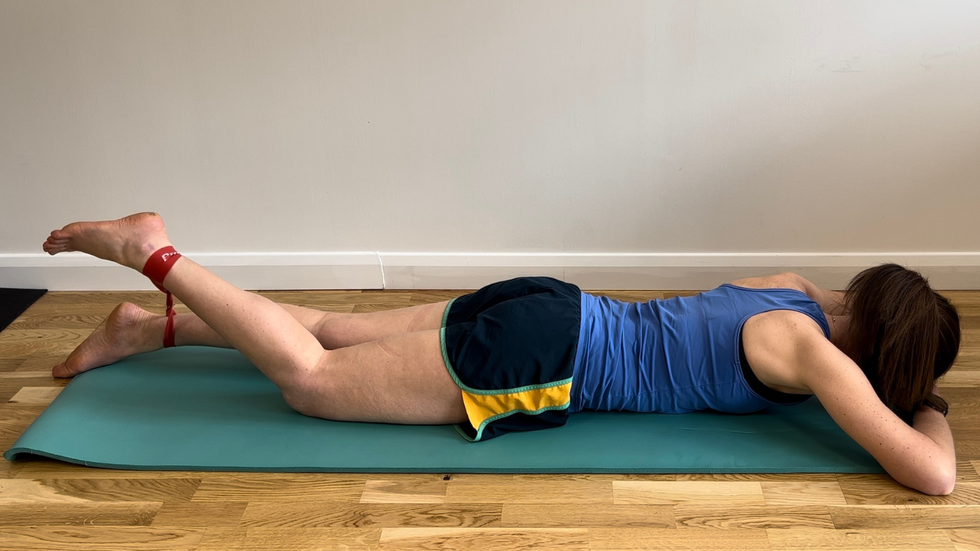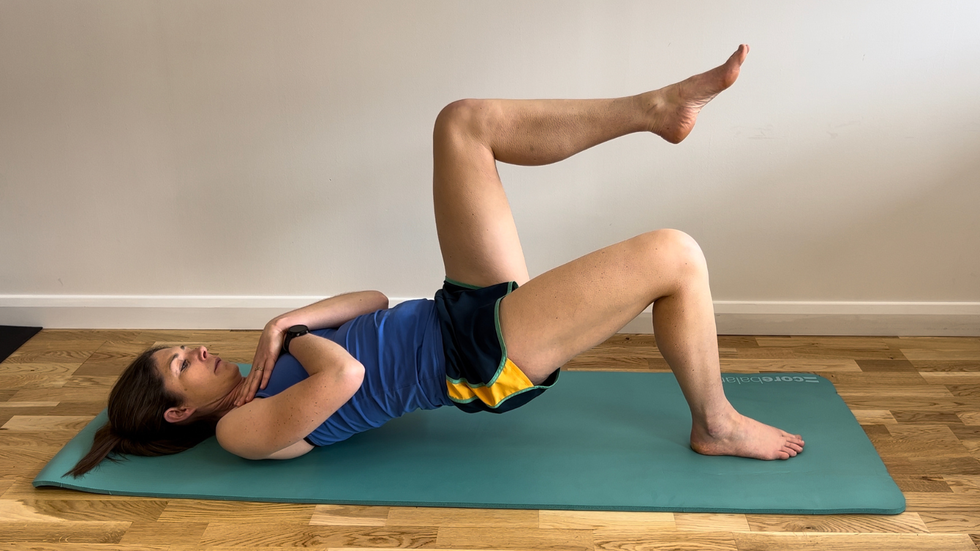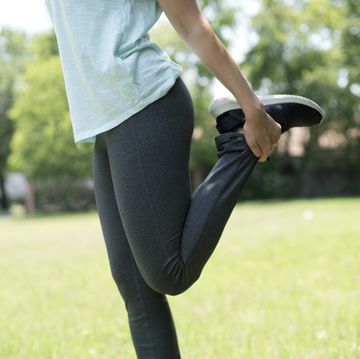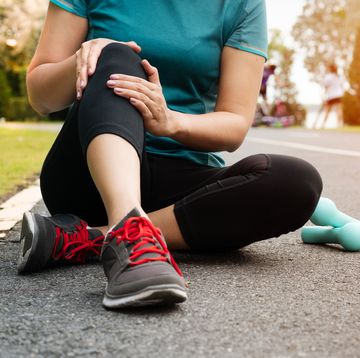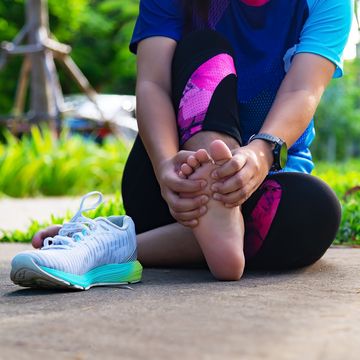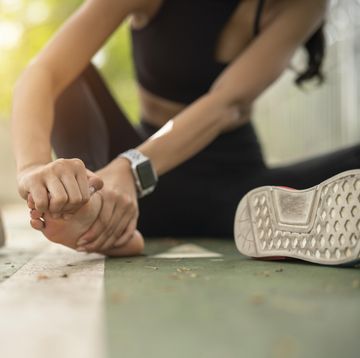You’ll know the feeling if you have tight hamstrings – your strides feel shorter, it seems like you’re working harder than usual and your legs feel stiff and restricted. Going faster or tackling hills aren’t realistic options. It’s a very common complaint among runners, but it can be helped. Here’s our guide to the causes of tight hamstrings, as well as seven of the best exercises to relieve that discomfort.
Where is the hamstring and what does it do?
Your hamstrings are actually several muscles located at the rear of your thighs, starting at the pelvis and going down to connect behind the knee joint. During running, they’re responsible for knee flexion, which is the drawing of your heel toward your glutes. Simultaneously, they drive hip extension, which is the backward sweep of your thigh that propels you forward. The hamstrings also act as shock absorbers, stopping your legs from overextending and taking the force of your feet hitting the ground.
What causes tight hamstrings in runners?
There are two main causes of hamstring tightness in runners: fatigue of the muscle or an underlying injury:
What everyone's reading
Hamstring fatigue
If you’re running longer distances or at greater speeds than usual, your hamstrings will tire, as will your others muscles. They may cope badly with the increased exertion of your runs, which will make them ache and feel tight. Trying to run through this feeling will only make it worse.
Pay attention to how you’ve been training if your hamstrings feel fatigued. Doing more speed sessions or hill work is hard on the hamstrings, while running faster also places much more demand on the hamstrings. As such, the tightness could be the result of a sudden increase in your training load.
If you aren’t working harder in training, maybe the issue is a change in your recovery. Your body finds it harder to get back to full strength after exercise if you’re sleeping more poorly, don’t get enough rest or are suffering from more stress than usual.
Lastly, hamstring tightness can be caused by a lack of muscular strength. The hamstring muscles – like any – are more likely to tire more quickly if you skip the strength and conditioning work that should go hand in hand with running.
Underlying injury
Sometimes, hamstring tightness is caused by an underlying injury to the hamstring muscle or tendon, or due to referred pain from the lower back or sciatic nerve, which passes through the hamstrings.
Hamstring muscle injuries
An injury to the hamstring muscles feels much more dramatic than general tightness. It commonly happens when you are running at speed, coming on as a sudden, sharp pain that stops you altogether. It will still feel sore for some time, while the muscle feels tight and weak.
Hamstring tendon injuries
A hamstring tendon injury tends to be felt at the higher end, where the muscle meets the pelvis. It’s a specific pain that gets worse when running, stretching or even sitting. The injury will feel stiffer after longer periods of rest, such as after sleep.
Referral from the back or nerve
The lumbar spine and sciatic nerve can cause pain that radiates into the hamstring region. So, if you have a combination of tight hamstrings and back pain, it could be sciatica. That does often include back pain, but sciatica can present without that. Movements that stress the lower back or stretch the nerve can be painful, such as bending forward, prolonged sitting or driving. Symptoms can spread into the calf or include pins and needles or numbness.
What types of runs aggravate tight hamstrings?
Faster runs and hillier runs challenge the hamstrings more. If your hamstrings are tight, you should skip these types of runs until the pain gets better.
How can runners relieve tight hamstrings?
Hamstring fatigue
When hamstring tension stems from muscle exhaustion, your priority should be giving yourself enough recovery time. Scale back your running volume and forget the high-intensity sessions like intervals or incline training for at least a week. Focus on quality sleep and rest days. Consider getting a massage or do some light foam rolling if it feels comfortable.
If the discomfort subsides naturally, you can gradually reintroduce your normal training pattern. Resist the urge to get straight back into demanding workouts, though.
To fight tightness over the long term, add specific hamstring strengthening exercises into your weekly routine. This will increase your muscles’ ability to handle training stress without becoming overly tight. While stretching can provide relief and is worthwhile, it won’t address underlying strength issues. Read on for some useful exercises.
Underlying injury
Treatment for hamstring injuries – whether it is a hamstring muscle or tendon injury, or sciatic nerve pain – can vary, so it’s always best to see a health professional for their expert input on what the injury is and how to treat it. In most cases, strength work will help, but it still needs to be adapted according to the injury and its symptoms. For example, for proximal hamstring tendon pain, exercises like the deadlift or hamstring stretches are often quite aggravating, especially in the early stages.
If the symptoms are too irritable, you may be forced to cut down your running or take a break. Once the pain has settled, your health professional can help you to plan a graded return to running. It’s usually best to build distance first – so that you can run comfortably for at least 30 minutes, for example – before increasing pace.
Other causes of tight hamstrings
Flexibility levels vary significantly among runners and some people get along perfectly well without ever being able to touch their toes, for example. In fact, some level of stiffness in the muscles can actually enhance running economy – think of them as acting like tightly coiled springs.
If this sounds like you and you currently aren’t experiencing discomfort or poor performance during your runs, don’t worry about it. But if you do wish to improve your flexibility, the ‘eccentric’ movements detailed below offer the dual benefits of building muscular strength and increasing range of motion. Plenty of runners also find that regular yoga does the job of keeping them flexible.
Some runners are less flexible than others, and in many cases they’ve always been this way. For example, many runners will say they’ve never been able to touch their toes and this isn’t necessarily a bad thing. In fact, having muscles that are a bit tighter can help running economy to some degree as they can work like tightly coiled springs as you run.
If you’re one of those runners, but you don’t feel like it impacts your running or causes you pain, then you shouldn’t be concerned. If you’d like to address it, the ‘eccentric’ exercises below are a good option to build both strength and flexibility. Some runners also report that they find yoga helpful for improving their flexibility.
Your running gait can also be a piece of the puzzle, if you run in a way that places more stress on the hamstrings. Although over-striding is the main issue for most runners, running with increased forward trunk lean or excessive anterior pelvic tilt can also play a role.
These aren’t harmful in themselves – running with an anterior pelvic tilt is normal and, in fact, it’s very hard to run without one. However, increasing your cadence by around 5-10% will address over-striding, which can reduce the demand on your hamstrings.
7 of the best exercises for tight hamstrings
Strengthening and stretching exercises should feel manageable and shouldn’t cause a lasting increase in symptoms. Before starting new exercises, it’s best to seek advice from a health professional.
The hamstring muscle group has three main roles: to flex the knee, to extend the hip and to work ‘eccentrically’ – like a break to slow the leg down during the swing phase of running. To address, these specific roles, it can help to include the following exercises into your routine.
Knee flexion
Prone curl with resistance band
- Put a resistance band around your ankles.
- Bend one knee to around 30-40 degrees.
- Hold for 10 seconds, then repeat five times.
- Progress by increasing the hold time.
- Once you can do five repetitions of 40 seconds, try a stronger resistance band.
Cable prone curl
- Safely attach the cable to your lower leg using an ankle strap.
- Lie on your stomach on a gym bench.
- Start with a light weight and slowly bend your knee against the resistance from the cable. Then, straighten the knee again.
- Do three sets of eight to 12 repetitions on each leg.
- If this feels easy, gradually increase the weight.
Hip extension
Double-leg bridge
- Start by lying down with your knees bent to around 90 degrees and your arms by your side.
- Lift your hips as high as you can comfortably, then slowly lower.
- Do three sets of eight to 12 repetitions.
- If this feels easy, progress by placing your hands across your chest while holding a light weight on your abdomen or by using the single-leg bridge below.
Single-leg bridge
- Start by lying with one foot on the floor with your knee bent to around 90 degrees. Lift the other leg up so that the hip is flexed to approximately 90 degrees.
- Lift your hips as high as you can comfortably, then slowly lower.
- Do three sets of eight to 12 repetitions on each leg.
- If this is too challenging, do fewer reps or place your arms by your side for more support.
- If this feels easy, progress by holding a light weight on your abdomen or by placing the foot of the working leg on a step.
Eccentric options
Kettlebell deadlift
- Stand with your feet shoulder-width apart and hold a light kettlebell in front of you.
- Bend your knees to approximately 30 degrees.
- Keep your back straight and lower the kettlebell toward the floor by hinging from your hips. (This can take some practice – you should feel it in your hamstring muscles rather than in your lower back.)
- Return to the start position by extending through your hips, keeping your knees slightly flexed.
- Do three sets of six to eight repetitions.
- If this feels easy, gradually increase the weight.
Single-leg kettlebell deadlift
- Balance on one leg while holding a light kettlebell.
- Bend the knee of your weight bearing leg to approximately 30 degrees.
- Keep your back straight and lower the kettlebell toward the floor by hinging from your hips, extending your other leg behind you as you lower.
- Return to the start position by extending through your hips, keeping your knee slightly flexed.
- Do three sets of six to eight repetitions.
- If this feels easy, gradually increase the weight.
- Note that this is a challenging exercise that requires good balance!
Stretches
- Lie on your back with one foot on the floor and your knee flexed.
- Straighten the other leg and use your arms to gently bring that leg up into a stretch position. (This should feel like a comfortable stretch, not a painful one!) You can also wrap a resistance band around the foot of your raised leg for a deeper stretch, as demonstrated in the picture above.
- Hold for up to 30 seconds and repeat four times on each leg.
- If this doesn’t feel manageable, try a shorter hold or fewer repetitions, or speak to a health professional for an alternative.
- For a deeper stretch, start with the other leg straight out while resting on the floor.

Tom Goom is a physiotherapist and running specialist whose website running-physio.com has gained a worldwide audience. He’s based at Body Rehab Studios in Hove and travels internationally to teach about running injury and how to treat it.
David Smyth once ran the London Marathon in less than three hours and is still going on about it. A journalist for more than two decades, he has been involved in races in Ethiopia, Chamonix and the Giant's Causeway, but is happiest going up and down chalky trails in the South Downs where he lives. Give him a race with fewer than 100 entrants and a banana at the finish and he won’t ask for anything more. David is a regular ‘Human Race’ columnist in Runner’s World magazine, which has allowed him the privilege of talking to dozens of people taking on extraordinary challenges who are changing lives through running.

